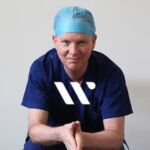
The neck is one of the first areas to show our age. And unless you live in scarves and polo neck sweaters, it’s hard to hide. So how do we beautify it?
Neck lifting is usually part of a facelift, but it can also be performed independently when there is no work required on the jowl or the jawline.
In the neck, the SMAS layer, which lies just under the skin, is continuous with the platysma. The platysma is the sheet of muscle that sits under the neck and does nothing really except twitch the skin. It might not sound important, but because laxity and ageing of the platysma often causes neck ageing, platysma elevation techniques are the cornerstone of neck improvement.
There are really two types of neck concerns that I see regularly in my rooms. First of all, there’s the patient who has an excellent neck shape and it is simply ageing. When we look at photos of these patients as young people, we see that they used to have a perfect neck. In cases like this, I typically tighten the platysma muscle and sling so that the skin is carried up and back, re-firms the jawline and allows the weakened structures to be repositioned. This usually gives an excellent result.
Then we turn to those who never really had a great neck shape. The aim here is to try and produce a better overall anatomic shape from the bone out to the skin. This can be achieved using submandibular gland resections, defatting, platysma slings and various other manoeuvres to smooth and shape the tissue under the chin. The mandible or jaw itself may need lengthening or augmenting. The ultimate aim is to make the plane of tissue tucked in just under the jawline smoother and flatter.
Once this is done, the mid and lower neck can be thinned if it is thickened with too much fat, and you are well set up for a good jawline and neck.
Lifting the platysma laterally to complete the platysma sling is performed through a facelift incision that goes around the ears, as well as a short incision under the chin to allow access to the front of the platysma under the neck. The stretched platysma is also responsible for the strands and many of the shape problems we see under the chin. This is why almost all my patients having lower face and necklifts have an anterior SMAS composite flap procedure and a platysmaplasty with manipulation of the platysma under the chin and fixation around the ears to create a strong platysmal sling. l often remove excess skin, and fat if required. Lastly, I often use fat grafting to increase the volume of the cheeks and upper face.
Once the deeper tissue manoeuvres are done, it’s quite rare to have a lot of excess skin. Interestingly, there’s not much more loose skin in a fat neck than a thin neck. If there is excess skin, it is moved upwards and laterally to around the ears and hairline where the excess is trimmed.
The thing to understand is that neck lifting is not about skin tightening so that the skin is re-draped. It’s really the deeper structures of the neck that are responsible for the lumpiness, irregularity or poor shape. So, the way to achieve a good neck shape is to make those structures smoother and more even. This means that when the skin drapes over them, they will look more like a vertical cylinder with a flat plane at the top.
I think it’s exciting that in the last 20 years we’ve seen some great developments in the evolution of surgical techniques for the neck. If you choose a skilled surgeon, you can confidently expect good neck rejuvenation results.
Thanks for reading and don’t forget to check out my earlier post if you haven’t already done so. How do I assess the neck when planning a facelift?
Take a look at my realself profile where you can read patient reviews.





